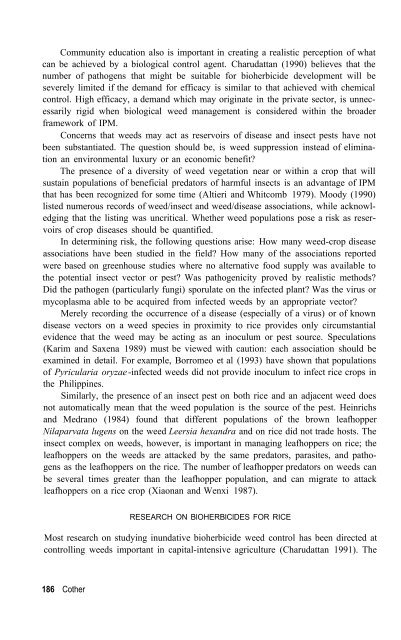HERBICIDES in Asian rice - IRRI books - International Rice ...
HERBICIDES in Asian rice - IRRI books - International Rice ...
HERBICIDES in Asian rice - IRRI books - International Rice ...
Create successful ePaper yourself
Turn your PDF publications into a flip-book with our unique Google optimized e-Paper software.
Community education also is important <strong>in</strong> creat<strong>in</strong>g a realistic perception of what<br />
can be achieved by a biological control agent. Charudattan (1990) believes that the<br />
number of pathogens that might be suitable for bioherbicide development will be<br />
severely limited if the demand for efficacy is similar to that achieved with chemical<br />
control. High efficacy, a demand which may orig<strong>in</strong>ate <strong>in</strong> the private sector, is unnecessarily<br />
rigid when biological weed management is considered with<strong>in</strong> the broader<br />
framework of IPM.<br />
Concerns that weeds may act as reservoirs of disease and <strong>in</strong>sect pests have not<br />
been substantiated. The question should be, is weed suppression <strong>in</strong>stead of elim<strong>in</strong>ation<br />
an environmental luxury or an economic benefit<br />
The presence of a diversity of weed vegetation near or with<strong>in</strong> a crop that will<br />
susta<strong>in</strong> populations of beneficial predators of harmful <strong>in</strong>sects is an advantage of IPM<br />
that has been recognized for some time (Altieri and Whitcomb 1979). Moody (1990)<br />
listed numerous records of weed/<strong>in</strong>sect and weed/disease associations, while acknowledg<strong>in</strong>g<br />
that the list<strong>in</strong>g was uncritical. Whether weed populations pose a risk as reservoirs<br />
of crop diseases should be quantified.<br />
In determ<strong>in</strong><strong>in</strong>g risk, the follow<strong>in</strong>g questions arise: How many weed-crop disease<br />
associations have been studied <strong>in</strong> the field How many of the associations reported<br />
were based on greenhouse studies where no alternative food supply was available to<br />
the potential <strong>in</strong>sect vector or pest Was pathogenicity proved by realistic methods<br />
Did the pathogen (particularly fungi) sporulate on the <strong>in</strong>fected plant Was the virus or<br />
mycoplasma able to be acquired from <strong>in</strong>fected weeds by an appropriate vector<br />
Merely record<strong>in</strong>g the occurrence of a disease (especially of a virus) or of known<br />
disease vectors on a weed species <strong>in</strong> proximity to <strong>rice</strong> provides only circumstantial<br />
evidence that the weed may be act<strong>in</strong>g as an <strong>in</strong>oculum or pest source. Speculations<br />
(Karim and Saxena 1989) must be viewed with caution: each association should be<br />
exam<strong>in</strong>ed <strong>in</strong> detail. For example, Borromeo et al (1993) have shown that populations<br />
of Pyricularia oryzae -<strong>in</strong>fected weeds did not provide <strong>in</strong>oculum to <strong>in</strong>fect <strong>rice</strong> crops <strong>in</strong><br />
the Philipp<strong>in</strong>es.<br />
Similarly, the presence of an <strong>in</strong>sect pest on both <strong>rice</strong> and an adjacent weed does<br />
not automatically mean that the weed population is the source of the pest. He<strong>in</strong>richs<br />
and Medrano (1984) found that different populations of the brown leafhopper<br />
Nilaparvata lugens on the weed Leersia hexandra and on <strong>rice</strong> did not trade hosts. The<br />
<strong>in</strong>sect complex on weeds, however, is important <strong>in</strong> manag<strong>in</strong>g leafhoppers on <strong>rice</strong>; the<br />
leafhoppers on the weeds are attacked by the same predators, parasites, and pathogens<br />
as the leafhoppers on the <strong>rice</strong>. The number of leafhopper predators on weeds can<br />
be several times greater than the leafhopper population, and can migrate to attack<br />
leafhoppers on a <strong>rice</strong> crop (Xiaonan and Wenxi 1987).<br />
RESEARCH ON BlOHERBlClDES FOR RICE<br />
Most research on study<strong>in</strong>g <strong>in</strong>undative bioherbicide weed control has been directed at<br />
controll<strong>in</strong>g weeds important <strong>in</strong> capital-<strong>in</strong>tensive agriculture (Charudattan 1991). The<br />
186 Cother

















